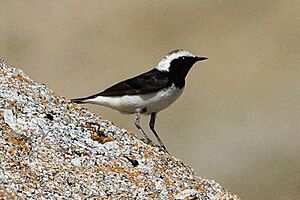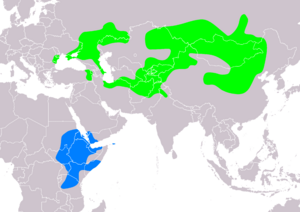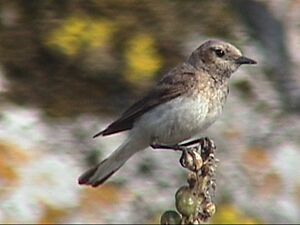Pied wheatear facts for kids
Quick facts for kids Pied wheatear |
|
|---|---|
 |
|
| Male | |
| Conservation status | |
| Scientific classification | |
 |
|
| Range of O. pleschanka Breeding Non-breeding | |
| Synonyms | |
|
The pied wheatear (Oenanthe pleschanka) is a small bird that loves to eat insects. It's a type of wheatear, which are birds known for their bright white rumps. This bird used to be thought of as a thrush, but now scientists say it's an Old World flycatcher.
Pied wheatears are migratory birds. This means they travel long distances between their breeding and winter homes. They live in central Asia, from southeastern Europe all the way to China. In winter, they fly south to places like India and northeastern Africa. Sometimes, they even visit western Europe, but that's very rare!
Male pied wheatears are easy to spot with their bold black and white feathers. They have a white head, a black face and throat, and a white rump. Females are mostly brown and look a bit smaller. Both males and females have a special "T" shape in black on their white tail feathers. These birds are about 14 centimetres (5.5 in) long. They build their nests in rocky areas, laying four to six eggs.
Contents
What's in a Name?
The name of the pied wheatear's group, Oenanthe, comes from ancient Greek words meaning "wine" and "flower." This is because the northern wheatear returns to Greece in spring when grapevines start to blossom.
The word Pleschanka is the Russian name for this bird. It refers to the bird's white cap, like a "bald spot" on its head.
The word "wheatear" might sound like it has to do with "wheat" or "ears," but it doesn't! It's actually an old word from the 1500s that means "white" and "rump." This name describes the bright white bottom that many wheatear species have.
How to Spot a Pied Wheatear
Male pied wheatears are quite striking. Their head and neck are usually pale brown, but as their feathers wear down, these parts become white. Their back and shoulders are black, and their rump (the area above the tail) is a creamy white. Their face, throat, and upper chest are black. The rest of their belly is a creamy-buff color. Their wings are black with creamy-buff edges.
Female pied wheatears look a bit different. Their back and shoulders are brown instead of black. Their tail feathers are brown and white, and their wings are brown with buff tips. Females are also a little smaller than males. Young birds look similar to females but have speckled brown upper parts.
When a pied wheatear calls, it makes a harsh zack zack sound. The male's song is low and musical. He sings from a high spot like a rock or even while flying. His song is a mix of different notes, sometimes like a lark, sometimes whistling.
Where They Live and Travel
Pied wheatears live in southeastern Europe and western Asia. They breed in countries like Romania and Bulgaria, all the way to Siberia and Mongolia. They can be found in mountains up to 3,000 metres (9,800 ft) high.
When winter comes, they fly south to northeastern Africa. They pass through southwestern Asia on their journey. During breeding season, they like open, rough areas with not many plants, like stony hillsides. In winter, they prefer similar places with rocks, scree (loose stones), or plains with thorny bushes. Sometimes, they even visit grassy areas or gardens.
Daily Life of a Wheatear
Pied wheatears can be a bit shy, but they are easy to see once you spot them. They usually live alone or in pairs in rocky areas. They like to perch on a bush or rock, looking around and bobbing their tail up and down.
When they see an insect, they quickly swoop down to the ground to grab it. Then, they fly right back to their perch. Their main food is small invertebrates like ants, grasshoppers, beetles, flies, moths, spiders, and mites. They also eat seeds sometimes.
Reproduction and Life Cycle
Pied wheatears build their nests in holes in riverbanks, under stones, or in cracks in rocks. They make their nests from dried grass stems and line them with thin roots and soft feathers.
Females lay four to six greenish-blue eggs. These eggs often have rust-colored spots on the larger end. They start laying eggs in early May. Usually, they have one group of chicks each year.
Conservation Status
The pied wheatear lives across a very large area in Eastern Europe and Western Asia. There are many of these birds, with estimates of hundreds of thousands in Europe alone. Because their population seems to be stable and they don't face any major threats, Birdlife International has listed them as a species of "Least Concern." This means they are not currently at risk of disappearing.



